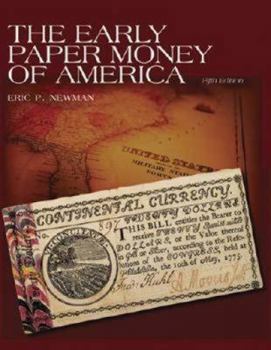The Early Paper Money of America
Select Format
Select Condition 
Book Overview
Complete historical and descriptive data on early American, colonial, state, and continental paper currency from 1686 to 1800. Eric P. Newman has completely revised and updated this popular book,... This description may be from another edition of this product.
Format:Hardcover
Language:English
ISBN:089689326X
ISBN13:9780896893269
Release Date:January 2008
Publisher:Krause Publications
Length:495 Pages
Weight:4.50 lbs.
Dimensions:1.5" x 8.6" x 11.1"
Customer Reviews
5 ratings
Early Paper Money of America
Published by Thriftbooks.com User , 15 years ago
This has been the "Bible" of Colonial and Continental paper money for decades. So nice to finally have one in color !
outstanding comprehensive illustrated reference on early American money
Published by Thriftbooks.com User , 15 years ago
Sharp close-up photographs of many paper bills throughout the text and also in a 20-page section of photos only demonstrate the printing and engraving art in early America. This can be especially appreciated in this Fifth Edition because of "highly improved color capability" for reproduction of photos, as Newman notes in his Preface. This Fifth Edition following by about 10 years the previous edition was desirable also to reflect "dramatic increases in values and improved research available through the Internet." The long subtitle given on the title page summarizes the content: "An illustrated, historical and descriptive compilation of data relating to American paper currency from its concept in 1686 to the year 1800, supplemented with current collector values encompassing emissions for the geographical area now constituting the United States of America by...." Following the "by..." are historical areas of the present-day United States where paper money was issued and categories of particular entities issuing such money. The areas familiar to ones knowing American history are English, French, and Spanish Colonies and from the short period 1775-1777, the United Colonies; and after this, the United States of America to 1787. The four categories of particular entities following these historical areas are Individual American States; American Cities and Counties; Private and Public Banks; and Individuals, Businesses, Churches, etc. Some entities in the last two categories independently issued paper money up to 1800. Early American paper money draws keen interest not only because of its age. It draws keen interest also because of its association with early America, thus putting it into the perennially popular area of Americana. But more than this, there is such keen interest because the paper money is virtually historical documents. Illustrations on many of the bills and often text and sometimes handwritten notations by one-time owners offer significant historical information in the same way that deeds, indentures, contracts, and other documents of the period do. Many of Newman's annotations--which in some cases grow into short essays--reflect this facet of the paper money. One paper bill issued by the state of Maryland in July 1775 is especially indicative of interest in this paper money for its documentary value. Newman writes, "On the face is a propaganda-filled woodcut by Thomas Sparrow, depicting Britain receiving a petition of the Continental Congress...from a female figure representing America; a scroll marked SLAVERY and holding a Liberty Cap in front of American troops...." The three indexes for printers, engravers, and designers; secondly, watermark; and thirdly, mottoes and emblematic legends correspond to primary, though not all, attributes making for interest in money. Current prices for an issue's different denominations with respect to different grades of condition are located with the issue's photograph and Newman's annotation. Hund
A Magnificent Reference
Published by Thriftbooks.com User , 15 years ago
I do not use these words lightly, but, in my opinion, this should be considerd the definitive reference on the subject. This volume, the new 5th Edition, is profusely illustrated with photogaphs of actual notes; many photos are in color. The book is well organized and is not limited to the paper money of the thirteen original colonies/states, but also includes sections dealing with Florida, Louisiana, the Northwest Territory, and Vermont. Naturally, an extensive section deals with Continental Currency.This book is the work of decades of research, which is reflected in the author's discussions of multiple historical avenues. By this I mean discussions of not only the notes themselves but also their evolution and use in the colonies, perhaps better described as an introduction to Colonial economics. Counterfeiting, valuation, relative purchasing power, printing styles and processes, and the various signers of respective notes, are all discussed. I must state that while this is an incredibly detailed book, it is also a very accessible book. Both novices to the field, as well as experienced collectors, will appreciate that the vast amount of information contained within it, while scholarly, does not bog down into mind numbing prose.The adage, "Buy the book, before the Note", represents some of the soundest advice that can be given to any collector. For those interested in early American paper money, this is the book to buy!!!
Awesome $
Published by Thriftbooks.com User , 21 years ago
This is a must for money buffs and the like.
THE best book to identify Colonial bills and their signers.
Published by Thriftbooks.com User , 22 years ago
Wonderful pictures, and even identification of the signers of the bills. Some signatures are hard to make out even if clearly written in dark ink due to the style of writting, but are identified here. Worth every penny!




